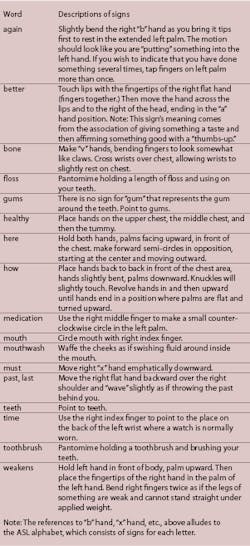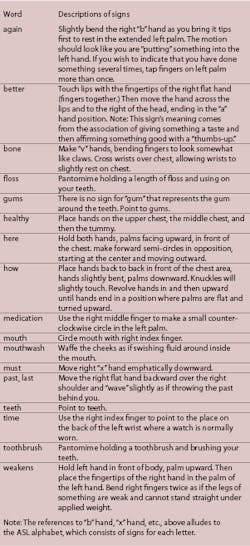Dental Signing
Although a whole separate language, American Sign Language offers simple phrases for communicating with the deaf.
One of my favorite patients once lost track of his wife. Walt walked from my operatory into the waiting room and was obviously surprised not to find her there. He turned back to the receptionist, pointed to his wedding ring, then raised both hands, palms up, and lifted his eyebrows.
Where’s my wife?
The receptionist looked confused. “I think I saw her drive out. Did she leave you here?”
Walt suddenly tapped his temple with a forefinger. He raised both fists to chest level and rocked them side-to-side in a semicircle. Then he raised two fingers.
Oh, yeah, I forgot. We brought two cars.
Then, in quick succession, he lifted a hand from waist-level to his mouth several times, pointed to his ring again, tapped his watch, and lifted one finger.
I’m meeting her for lunch at one o’clock.
Walt has been deaf since birth, but he’s a college-educated engineer who has raised two sons and is active in his community. Few of the people around him can speak his native language - American Sign Language - but Walt lives successfully in a hearing world because he’s developed pantomime to a fine art. He can also write very well in English, something that’s difficult for many deaf people, so if miming fails, he just pulls a notebook out of his pocket.
It’s always a challenge when deaf people come into a dental office. Walt made it easy for us, but many times it can be difficult and stressful for both patient and clinician. Think how much more stressful it is in a medical environment. A deaf person, their spouse, their child, or their parent might suffer a heart attack, be an accident victim, or have any one of a dozen ailments that require sudden, unexpected medical attention.
Considering situations like that is what led deaf educator Elaine Ernst Schneider of Montgomery, Alabama, and registered nurse Joanne Mikola of Oakville, Ontario, to develop Lesson Tutor, a Web site that introduces American Sign Language (ASL) to hearing people.
The two met online five years ago because both had an interest in writing curriculum. They’ve never met in person.
“I had the idea for a Web site,” Schneider says, “and Joanne knew how to build one. I draw the signs and write the syntax, scan them, and send them to Joanne. She cleans them up, puts it all in a nice format, and adds them to the Web site.” Each sign diagram is accompanied by a written description of the sign.
The site, at www.lessontutor.com, includes hundreds of pages of signs and lesson plans. There are signs that babies can learn, and basic signs for stroke victims. There’s an online store at which one can buy flashcards and manuals.
“Since we’ve started,” Schneider says, “we’ve stretched in a lot of different directions. People tell us what they need, and we create it. That’s how the health-care package came about.”
Lesson Tutor offers a 16-page manual for health-care professionals that teaches ASL for common emergency situations. One of the first sentences taught in the manual is a disclaimer: “I do not read signs, but I have learned to sign a few questions so that I can help you.”
With that said, a health-care professional can then ask simple questions, such as:
• What is the problem?
• Where do you hurt right now?
• Have you taken medicine today?
• What medicines can you not take?
• Do you have a history of headaches?
The manual includes a diagram and a word description of each sign needed for each sentence.
Besides “Introducing ASL to Health-Care Professionals,” the site offers dozens of other manuals and flashcard sets, including “ASL Survival Signs,” “Toddler Tasks in Simple Signs,” and three volumes of “Sign and Sing a Song for Christmas.”
The first thing a hearing person needs to know about deafness, says Schneider, is that deafness is not a mental deficiency. It’s simply a physical problem like a missing limb or poor vision.
One reason hearing people might think a deaf person is mentally deficient is because the deaf often have trouble writing in English.
“Sign language is concept-oriented,” Schneider says. “People who have been deaf from birth often struggle with English syntax, and their written sentences are not in the order that hearing persons are accustomed to seeing.”
For example, a hearing health-care professional might say, “Have you treated this injury yourself?” To interpret that, an interpreter would sign, “Try you, fix hurt?”
The ASL vocabulary is also smaller than English vocabulary. “I was interpreting recently,” Schneider recalls, “and the hearing person said ‘terrain.’ There’s no sign for ‘terrain,’ so I just signed ‘land.’ To a deaf person, the two words are exactly the same, conceptually.”
It’s typical that there is no distinction between verbs and nouns, Schneider adds. The verb ‘brush’ and the noun ‘brush’ are signed the same - by pantomiming brushing your teeth.
So unlike my patient Walt, many deaf people can’t just pull out a notebook to ask for what they need. Why?
“The answer,” says Schneider, “has a great deal to do with the type of deafness, the onset of the deafness, and the extremity of the hearing loss. Children with mild to moderate deafness will probably be able to grab bits of language that they can use as a foundation for syntax. The child who is born profoundly deaf lacks the advantage of receptive language. There is no foundation on which to build.”
Another communication problem deaf people have is that not all of them can read lips.
“Compare this to being in the Mormon Tabernacle Choir,” Schneider says as an example. “Just because I stand in the soprano section does not mean that I can sing. Lip reading is a talent. Try turning off the sound of your television and lip-reading what the characters are saying. You will see how very closely some sounds resemble one another when you are totally dependent on lip reading. Yes, some people with hearing loss can lip-read - they’re blessed with that ability. But just being deaf doesn’t give them that talent.”
Deaf people can be defensive or embarrassed about their inability to communicate with hearing people. “Imagine,” says Schneider, “that you are a six-year-old student who was born profoundly deaf. You are placed in a school that does not allow communication in signs, and you are required to read lips. You really try, but you just don’t have the talent. You would soon become defensive.”
It might also cause embarrassment, she says, if someone suggested to a deaf person that they communicate with notes. “If a person with hearing loss is uncomfortable with notes, then just the sight of pen and paper would telegraph to that person the possibility that he or she might be misunderstood. A person who comes to the dentist for the first time is nervous anyway, and to add the element of communication in a means that is uncomfortable to them just adds to the tension.”
Given the problems deaf people have with traditional means of communication, it makes sense for health-care professionals - including dental hygienists - to take the time to learn some ASL signs. As you communicate with a deaf person, remember what my patient Walt taught us: Pantomime goes a long way, and basic signing is simple and intuitive.
Suppose you wanted to encourage a deaf child to brush after eating. You could make the sign for eating - put all the fingertips of one hand together and touch them to your mouth - then make the sign for brushing by pantomiming the action. Repeat that a few times, then pick up your typodont and make it do a little happy dance. What could be simpler?
With the basics included here, plus some help from Lesson Tutor, both you and your deaf patient can be more confident and comfortable.
Cathy Hester Seckman, RDH, is a frequent contributor based in Calcutta, Ohio. She can be reached at [email protected].

